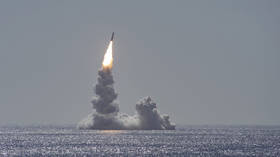US push for low-yield nukes makes atomic war MORE likely as Russia will retaliate with full force, Moscow says

The US State Department’s case for tactical nuclear weapons is a case study in psychological projection not seen since the darkest days of the Cold War and its ever-present threat of world-ending atomic holocaust.
Back in February, the Pentagon announced the US Navy has fielded the first batch of W76-2 low-yield submarine launched ballistic missile (SLBM) warheads. A paper by the State Department’s Bureau of Arms Control, published last week, aimed to explain the reasoning behind this move and “debunk” the critics. The 10-page document was endorsed by the acting Under Secretary for arms control Christopher Ford, who hailed the missiles as “reducing net nuclear risks.”
Also on rt.com Russia & US are rushing into new arms race as they run out of time for realistic arms-control dealOn Wednesday, however, Russian Foreign Ministry spokeswoman Maria Zakharova called the move “a deliberate blurring of the lines between non-strategic and strategic nuclear weapons” that “inevitably leads to a lowering of the nuclear threshold and an increase in the threat of nuclear conflict.”
Everyone who wants to do this should understand that according to the Russian military doctrine, such actions will be considered the basis for the reciprocal use of nuclear weapons by Russia
At the root of this discrepancy is a fundamental misunderstanding. Foggy Bottom and the Pentagon are basing their arguments not on the actual Russian doctrine or behavior, but on their belief as to what those might be.
Also on rt.com Step to nuclear doomsday: US puts low-yield nukes on submarines to counter made-up Russian ‘strategy'For example, there is an unquestioned assumption in US policy circles that Russia has a nuclear doctrine described as “escalate to de-escalate” – which “purportedly seeks to deescalate a conventional conflict through coercive threats, including limited nuclear use,” according to a 2015 congressional testimony of then-Deputy Secretary of Defense Robert Work.
As former UN weapons inspector Scott Ritter pointed out, Work’s own words reveal that this is not the actual Russian doctrine, but the impression of it by some US analysts. Whoever originated this utter fantasy is irrelevant; it ranks right alongside Molly McKew’s“expertise” on Russian nuclear posture or the likewise widespread acceptance of the nonexistent “Gerasimov Doctrine.”
READ MORE: The problem with the 'Gerasimov Doctrine' is that it doesn’t exist
The State Department’s paper is indeed based on Work’s assumptions about Russia, as it literally talks about the US “deterrence objective of undermining Russian confidence that it can control escalation in a nuclear war.”
In struggling to understand where this notion may have come from, I remembered a 1978 fiction book about World War III by Sir John Hackett, a British general. Hackett envisioned a Soviet nuclear strike on a European NATO capital after the conventional war started going badly for the USSR. In the book, NATO responds with a nuclear strike on Minsk, and the war ends with a coup in Moscow by Ukrainian nationalists (stop me if you’ve heard that one before!). It may sound insane that a 42-year-old fantasy appears to be the basis of US thinking about current Russian strategy, yet here we are.
The other thing that’s downright alarming about the State Department paper is its talk of a “limited response to demonstrate resolve.” Considering that the US is the only country in the world to ever use nuclear weapons in combat – against primarily civilian targets, no less – there is no reason for anyone to doubt Washington’s “resolve.” Go read their argument; it seems to be one giant straw man, composed of wishful thinking, projection and mirror imaging – textbook mistakes its authors should have known better than to make.
Which gets us to the fundamental misunderstanding at work here. Over the course of its 244-year history, almost every US war has been fought abroad and by choice. By contrast, Russian wars tend to be fought at home and against foreign invaders. Russians do not think of war in terms of posturing, but in terms of life and death. They don’t need to “demonstrate resolve” – not after countless documented acts of bravery against overwhelming odds.
Also on rt.com After nuclear holocaust, we’ll go to heaven as martyrs; attackers will die as sinners – PutinMoreover, Russian President Vladimir Putin literally spelled out his country’s nuclear doctrine back in 2018, on two separate occasions. “Why would we want a world without Russia?” he said in March, illustrating the notion that Moscow is willing to use atomic weapons if the survival of Russia was endangered, even if by conventional means. Several months later, in October, he was even more graphic.
Any aggressor should know that retribution will be inevitable and he will be destroyed. And since we will be the victims of his aggression, we will be going to heaven as martyrs. They will simply drop dead, won’t even have time to repent.
Yet here are the Pentagon and the State Department, ignoring this observable reality in favor of their own wishful thinking that may well be based on decades-old fantasies from a world long since gone. As Zakharova correctly points out, that’s not making the world safer – not even a tiny bit.
Think your friends would be interested? Share this story!
The statements, views and opinions expressed in this column are solely those of the author and do not necessarily represent those of RT.














